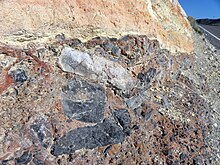



Breccia (/ˈbrɛtʃiə, ˈbrɛʃ-/) is a rock composed of large angular broken fragments of minerals or rocks cemented together by a fine-grained matrix.
The word has its origins in the Italian language, in which it means "rubble".[1] A breccia may have a variety of different origins, as indicated by the named types including sedimentary breccia, fault or tectonic breccia, igneous breccia, impact breccia, and hydrothermal breccia.
A megabreccia is a breccia composed of very large rock fragments, sometimes kilometers across, which can be formed by landslides,[2] impact events,[3] or caldera collapse.[4]
- ^ Allaby, Michael, ed. (2013). "Breccia". A dictionary of geology and earth sciences (Fourth ed.). Oxford: Oxford University Press. ISBN 9780199653065.
- ^ Biek, Robert F. (May 2013). "The Early Miocene Markagunt Megabreccia: Utah's largest catastrophic landsline". Utah Geological Survey Notes. 45 (2). Retrieved 28 July 2020.
- ^ McEwen, A. S.; Tornabene, L.; Grant, J.; Wray, J.; Mustard, J. (2008). "Noachian Megabreccia on Mars". American Geophysical Union, Fall Meeting. 2008: P43D–03. Bibcode:2008AGUFM.P43D..03M. Retrieved 28 July 2020.
- ^ Goff, Fraser; Gardner, Jamie N.; Reneau, Steven L.; Kelley, Shari A.; Kempter, Kirt A.; Lawrence, John R. (2011). "Geologic map of the Valles caldera, Jemez Mountains, New Mexico". New Mexico Bureau of Geology and Mineral Resources Map Series. 79. Bibcode:2011AGUFM.V13C2606G. Retrieved 18 May 2020.